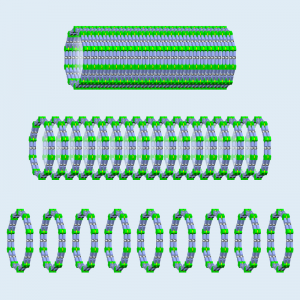Nanotubes get cut and pasted Reversible transformation between nanotubes and nanorings

Selective cleavage and formation of covalent bonds, which connect atoms strongly to build up large molecules, are key technologies for the synthesis of complicated organic molecules eventually useful for pharmaceutical applications. If a similar ‘modular approach’ involving cutting, recombining, and pasting could be applied to noncovalent synthesis, it might be possible to create exotic or challenging nanostructures. However, this idea has been considered unrealistic, since selective attenuation and/or enhancement of particular noncovalent forces among many used for nanostructuring is indeed a difficult task.

© 2014 Takahiro Fukino.
Schematic illustration of a nanostructure that can be reversibly cut into its constituent modules in response to external stimuli. A nanotube (upper image) including ferrocene units has been developed that can selectively be cut upon electron ejection (ferrocene oxidation) into its constituent nanoring modules (lower image). These nanorings in turn stack up uniaxially on top of each other upon electron re-injection (ferrocene reduction) and reassemble back into the original nanotube.
A research group at the University of Tokyo’s Graduate School of Engineering Department of Chemistry and Biotechnology including Professor Takuzo Aida (concurrently Deputy Director, Riken Center for Emergent Matter Science), Takahiro Fukino and their colleagues developed an extraordinary nanostructure that may address this difficult issue in nanoscale synthesis. The nanostructure thus developed is a tubular shape that can selectively be cut upon electron ejection (oxidation) into its constituent nanoring modules, which in turn stack up uniaxially on top of each other upon electron re-injection (reduction), reassembling into the original nanotube. Since the nanoring is positively charged, it can be pasted onto negatively charged surfaces of other substances.
This seminal new strategy of “cutting, recombining, and pasting at the nanoscale” demonstrated in the present work is expected to contribute greatly to the progress of science and technology of highly complex and functional nanostructures, and will contribute greatly to the development of next-generation electronic devices.
Paper
Takahiro Fukino, Hyunho Joo, Yuki Hisada, Maiko Obana, Hiroshi Yamagishi, Takaaki Hikima, Masaki Takata, Norifumi Fujita, Takuzo Aida,
“Manipulation of Discrete Nanostructures by Selective Modulation of Noncovalent Forces”,
Science Online Edition: 2014/4/10, doi: 10.1126/science.1252120.
Article link
Links
Graduate School of Engineering
Department of Chemistry and Biotechnology, Graduate School of Engineering
Aida Laboratory, Department of Chemistry and Biotechnology, Graduate School of Engineering







